Top 10 Best Cloud Cost Optimization Tools for 2025
Discover the best cloud cost optimization tools to reduce expenses and improve efficiency. Find the top solutions for your DevOps team today!

Navigating the complexities of cloud billing is a critical challenge for modern DevOps and finance teams. Unchecked, cloud spend can quickly spiral out of control, eroding margins and hindering innovation. The solution lies in moving from reactive cost analysis in spreadsheets to proactive, automated optimization. This requires a robust FinOps culture supported by the right technology. To truly master cloud spend, it's essential to not only leverage the right FinOps toolkit but also implement powerful cloud cost optimization strategies.
This guide dives deep into the 12 best cloud cost optimization tools available today, moving beyond marketing claims to provide a technical, actionable analysis. We cut through the noise to deliver an in-depth resource tailored for CTOs, platform engineers, and DevOps leaders who need to make informed decisions. We'll explore native cloud provider tools, specialized third-party platforms, and Kubernetes-focused solutions, examining their core architectures, implementation nuances, and specific use cases.
Inside this comprehensive review, you will find:
- Detailed profiles of each tool, complete with screenshots and direct links.
- Technical breakdowns of key features, from cost allocation models to automated rightsizing.
- Practical use cases showing how to apply each tool to specific engineering challenges.
- Honest assessments of limitations and potential implementation hurdles.
Our goal is to help you select the precise solution that aligns with your technical stack, team structure, and business objectives. We'll show you how to build a cost-efficient, high-performance cloud infrastructure by choosing the right platform for your unique needs.
1. AWS Marketplace – Cloud cost management solutions hub
The AWS Marketplace isn't a single tool but rather a centralized procurement hub where you can discover, trial, and deploy a wide array of third-party cloud cost optimization tools. Its primary value proposition is streamlining vendor management and billing. Instead of juggling multiple contracts and invoices, you can subscribe to various solutions and have all charges consolidated directly into your existing AWS bill. This is particularly effective for teams already deeply embedded in the AWS ecosystem.
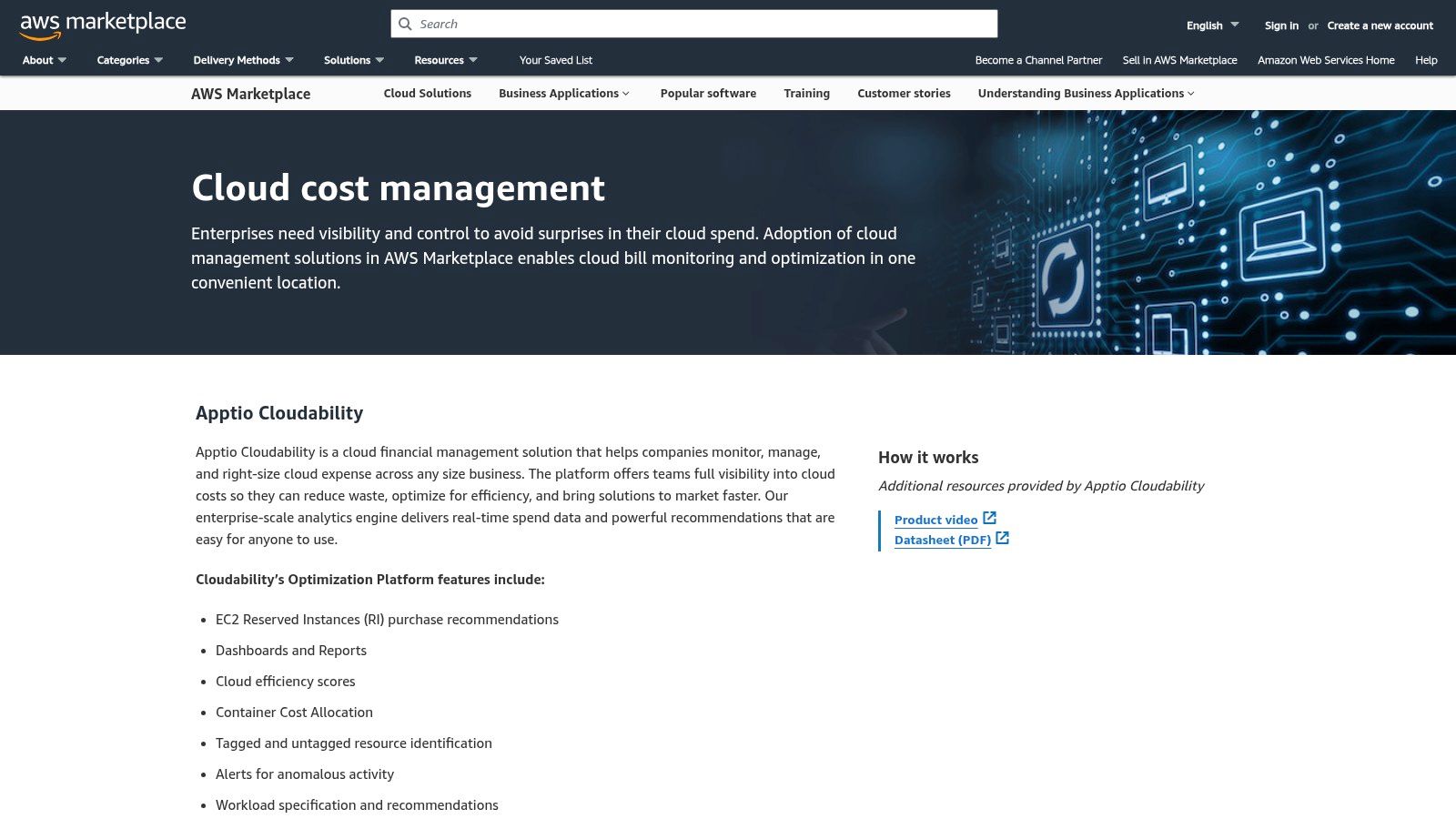
This platform simplifies the technical and financial overhead of adopting new software. For engineering leaders, this means faster access to tooling, as procurement can often be handled via private offers within the Marketplace, leveraging pre-approved AWS spending commitments. This approach significantly reduces the friction of onboarding a new vendor, making it one of the best cloud cost optimization tools for organizations seeking operational efficiency.
Key Considerations
- Procurement Model: The ability to use AWS credits or Enterprise Discount Program (EDP) commitments to purchase third-party software is a major draw.
- Vendor Selection: While extensive, the catalog naturally favors tools with strong AWS integrations. You may find fewer options for multi-cloud or non-AWS-specific solutions.
- User Experience: The interface provides standardized listings, making it easy to compare features and initiate trials. However, detailed pricing often requires requesting a private offer directly from the vendor.
| Feature | Analysis |
|---|---|
| Centralized Billing | Consolidates software costs into your AWS invoice, simplifying accounting and budget tracking. |
| Private Offers | Enables negotiation of custom pricing and terms directly with vendors, fulfilled through AWS. |
| Simplified Deployment | Many listings offer one-click deployment via CloudFormation templates, accelerating implementation. |
Practical Tip: Before committing, use the free trial option available for many tools. This allows you to evaluate a solution's real-world impact on your infrastructure without financial risk. Integrating these platforms is a key part of holistic cloud infrastructure management services that focus on both performance and cost.
Website: aws.amazon.com/marketplace
2. AWS Cost Explorer
AWS Cost Explorer is the native, no-extra-license tool integrated directly into the AWS Management Console for visualizing, understanding, and managing your AWS costs and usage. It serves as the foundational layer for cost analysis within the AWS ecosystem, providing default reports and customizable views with daily or monthly granularity. Its main advantage is its seamless integration, offering immediate insights without the need for third-party subscriptions or complex setup.
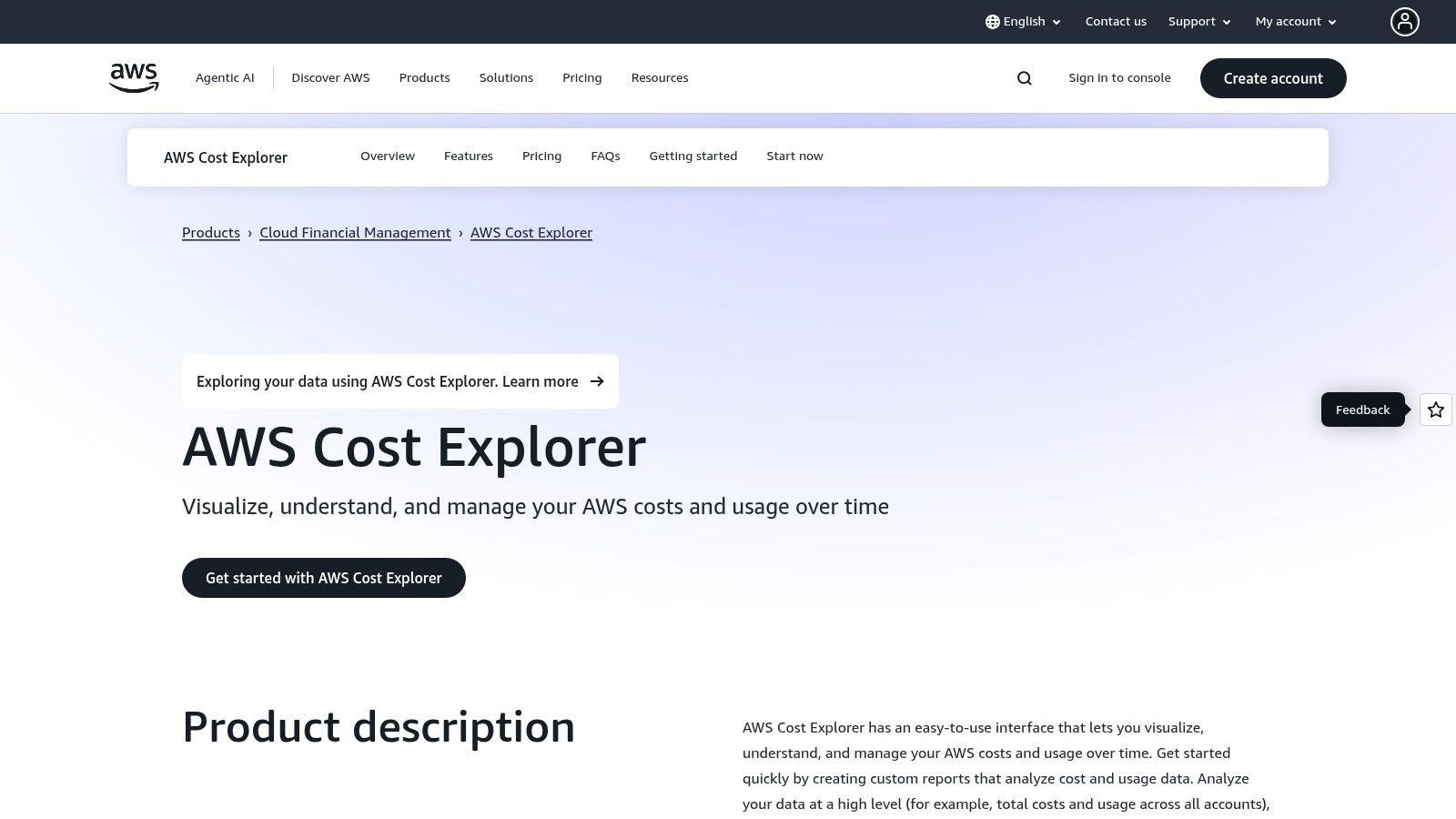
For engineering teams and CTOs, Cost Explorer is the first stop for identifying spending trends, forecasting future expenses, and detecting anomalies. You can filter and group data using tags, accounts, or services to pinpoint which resources are driving costs. While it provides a solid baseline, advanced analysis often requires combining its data with other tools. For instance, teams frequently build more sophisticated dashboards by programmatically extracting raw billing data from AWS to feed into external business intelligence platforms.
Key Considerations
- Accessibility: As a native tool, it’s available to all AWS customers without a separate subscription, making it a zero-friction starting point for cost management.
- Data Granularity: While daily and monthly views are free, enabling hourly and resource-level granularity incurs a small fee, which is crucial for detailed performance-to-cost analysis.
- Automation Limitations: The tool is primarily for visualization and exploration. Implementing automated cost-saving actions based on its findings typically requires custom development using the AWS SDK or third-party solutions.
| Feature | Analysis |
|---|---|
| Cost Visualization | Offers pre-configured and custom reports to track spending trends, helping identify unexpected cost spikes. |
| Forecasting Engine | Predicts future costs based on historical usage patterns, aiding in budget planning and financial modeling. |
| Filtering & Grouping | Allows deep dives into cost data by filtering by service, linked account, region, or cost allocation tags. |
Practical Tip: Leverage cost allocation tags from day one. By tagging resources with identifiers like project, team, or environment, you can use Cost Explorer to generate highly specific reports that attribute spending directly to business units, which is essential for accurate chargebacks and accountability.
Website: aws.amazon.com/aws-cost-management/aws-cost-explorer/
3. Microsoft Azure Cost Management + Billing
As Microsoft's native FinOps suite, Azure Cost Management + Billing is the foundational tool for organizations operating primarily on the Azure cloud. It provides a comprehensive set of capabilities for monitoring, controlling, and optimizing Azure spending directly within the portal. Its greatest strength lies in its seamless integration with the Azure ecosystem, offering granular visibility into consumption data and robust governance features without requiring any third-party licenses.
The platform is designed for enterprise-grade control, enabling engineering leaders to set budgets with proactive alerts, detect spending anomalies, and allocate costs precisely using tag inheritance and shared cost-splitting rules. For deep, customized analysis, its integration with Power BI allows teams to build sophisticated dashboards and reports, making it one of the best cloud cost optimization tools for data-driven financial governance within an Azure-centric environment.
Key Considerations
- Native Integration: Being a first-party service, it offers unparalleled access to Azure billing data and resource metadata, with no extra licensing fees.
- Multi-Cloud Limitations: While it has some capabilities to ingest AWS cost data, its most powerful features for optimization and governance are exclusive to Azure resources.
- Data Latency: Cost data is refreshed periodically throughout the day, not in real-time, which can introduce a slight delay in detecting immediate spending spikes.
| Feature | Analysis |
|---|---|
| Budget & Anomaly Alerts | Set spending thresholds and receive automated notifications for unexpected cost increases or overruns. |
| Cost Allocation | Use powerful rules to split shared costs and distribute expenses accurately across teams or projects. |
| Power BI Integration | Connects directly to a rich dataset for creating custom, interactive financial reports and dashboards. |
Practical Tip: Leverage the automated export feature to schedule regular data dumps into an Azure Storage account. This creates a historical cost dataset that you can query directly or feed into other business intelligence tools for long-term trend analysis beyond the portal's default retention periods.
Website: learn.microsoft.com/azure/cost-management-billing/costs/overview-cost-management
4. Google Cloud cost management stack (Budgets/Alerts + Recommender)
Google Cloud’s native cost management stack offers a powerful, built-in suite of tools for teams operating primarily within the GCP ecosystem. It combines proactive budget setting and alerting with intelligent, automated recommendations to curb unnecessary spending. This integrated approach allows engineering leaders to enforce financial governance directly within the platform where resources are consumed, making it a foundational element of any GCP-centric cost optimization strategy.
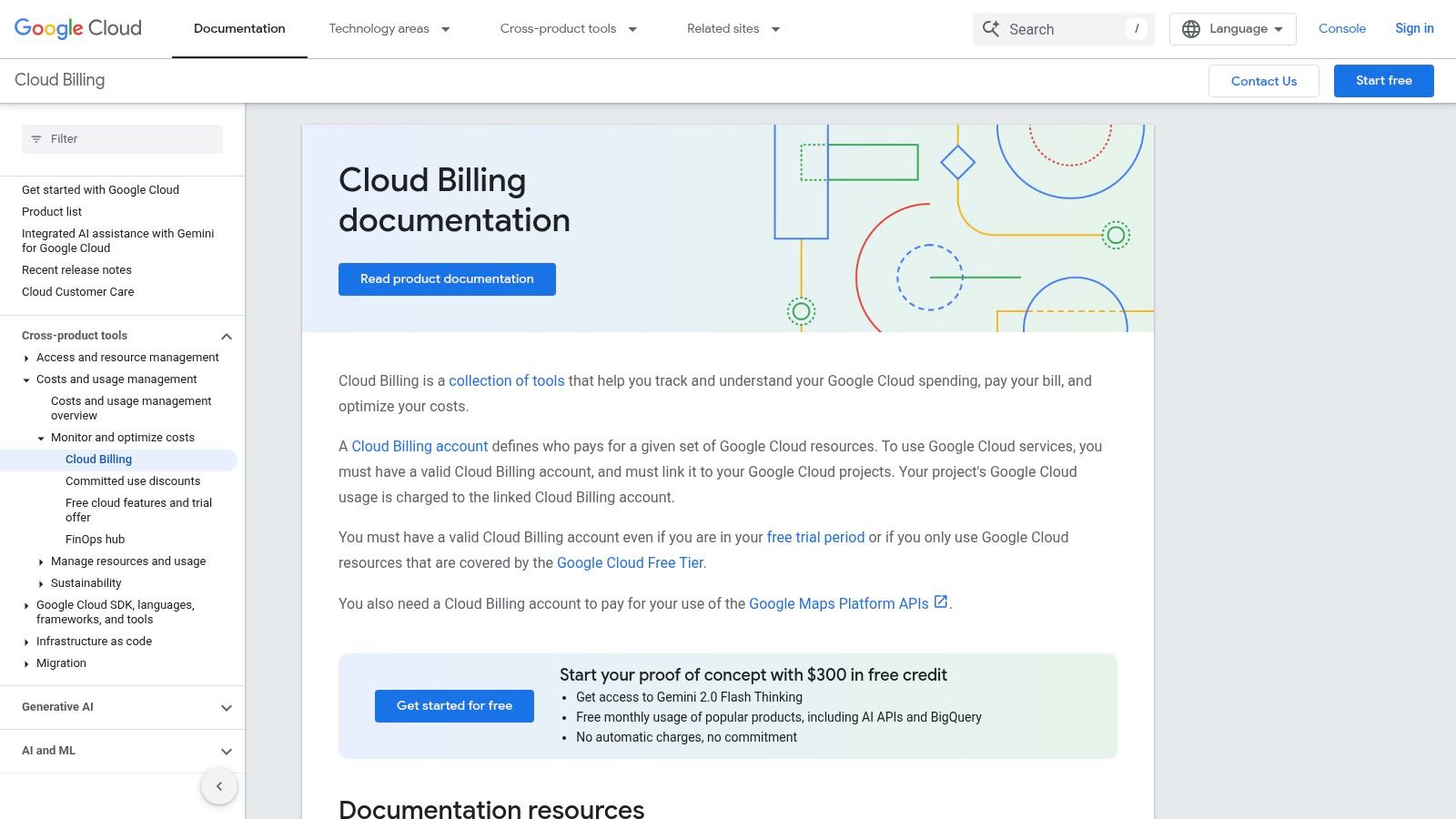
The core components, Cloud Billing Budgets and the Recommender API, work together to provide both manual control and machine-learning-driven insights. Budgets can be configured to trigger notifications at specific spending thresholds, and more advanced users can automate actions-like disabling billing or throttling resources-using Pub/Sub notifications. This makes Google's native offering one of the best cloud cost optimization tools for organizations that value deep platform integration and automated responses without third-party licensing costs.
Key Considerations
- Platform Integration: As a native solution, these tools are deeply woven into the GCP console, providing context-aware recommendations and seamless access to cost data.
- Automation Hooks: The use of Pub/Sub topics for budget alerts enables sophisticated, event-driven automation, such as triggering Cloud Functions to resize instances or shut down non-critical projects.
- Scope Limitations: The entire stack is inherently GCP-specific. Teams with multi-cloud or hybrid environments will need a separate, overarching tool for a complete financial overview.
| Feature | Analysis |
|---|---|
| Budgets & Alerts | Set granular budgets by project, service, or label, with programmatic alerts via email and Pub/Sub. |
| Recommender API | Provides AI-driven suggestions for rightsizing VMs, deleting idle resources, and purchasing commitments. |
| Cost Analysis Reports | Visualize spending trends with detailed, customizable reports that can be exported to BigQuery for deeper analysis. |
Practical Tip: Leverage the Recommender API to automatically identify and act on optimization opportunities. You can script the process of applying rightsizing recommendations to development environments during off-peak hours, ensuring you capture savings without manual intervention.
Website: cloud.google.com/billing
5. CloudZero
CloudZero positions itself as a cost intelligence platform, moving beyond simple spend monitoring to map cloud costs directly to business metrics. Its core strength lies in translating complex infrastructure spend into understandable unit costs, such as cost-per-customer or cost-per-feature. This approach empowers engineering and finance teams to collaborate effectively by tying technical decisions directly to business value and profitability.
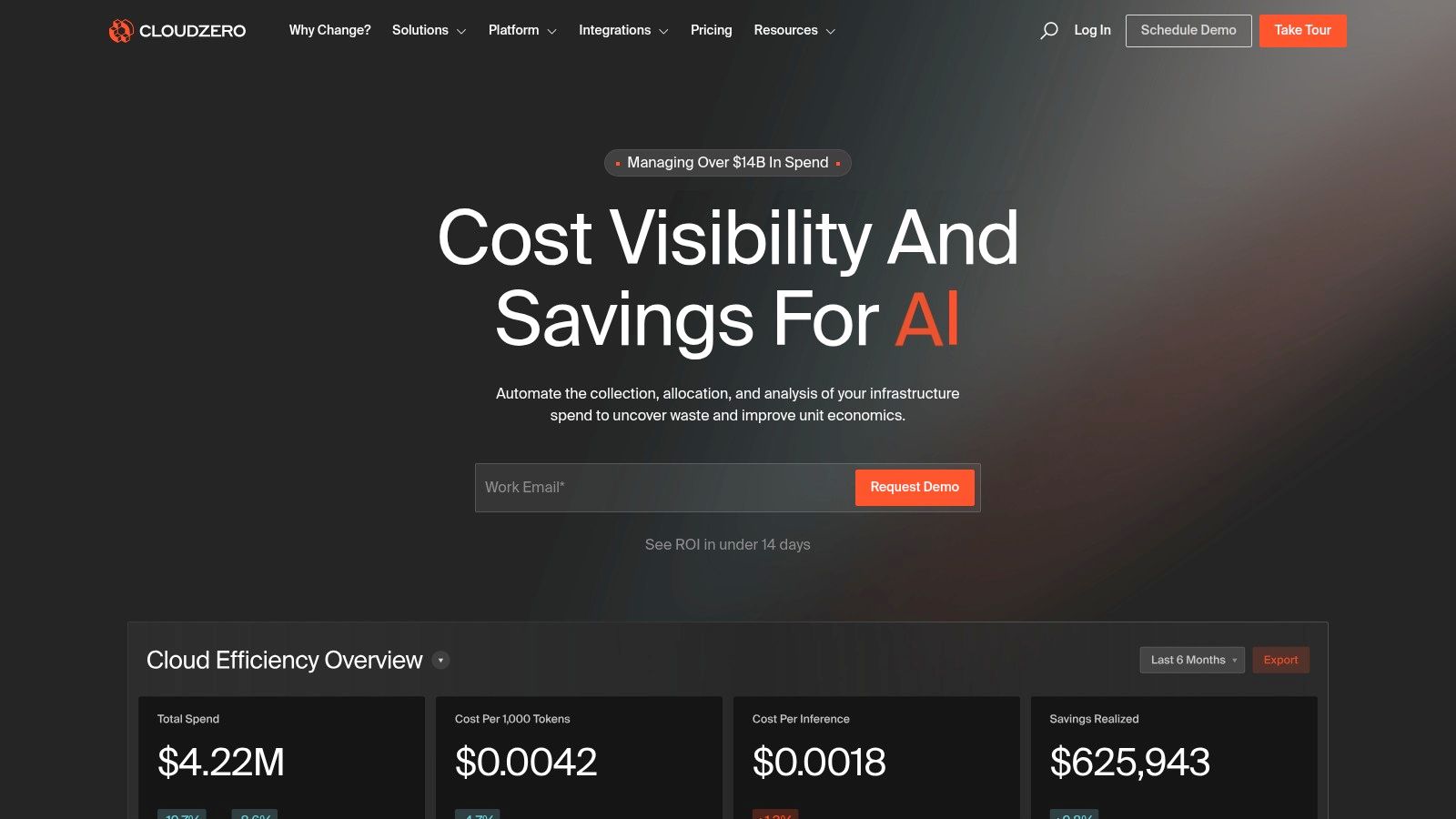
This platform is particularly powerful for SaaS companies where understanding tenant-level profitability is critical. By aggregating data from AWS, PaaS providers like Snowflake, and Kubernetes, CloudZero provides a holistic view of the COGS for specific product features. For engineering leaders, this shifts the conversation from "How much are we spending?" to "What is the ROI on our spend?", making it one of the best cloud cost optimization tools for organizations focused on unit economics.
Key Considerations
- Business-Centric Metrics: The focus on unit costs (e.g., cost per tenant, per API call) provides actionable data for pricing, engineering, and product strategy.
- Tagging Dependency: Achieving maximum value from the platform requires a mature and consistent resource tagging strategy across your infrastructure.
- Pricing Model: Pricing often scales with your cloud spend, especially when purchased via the AWS Marketplace, which can be a significant factor for large-scale operations.
| Feature | Analysis |
|---|---|
| Unit Cost Telemetry | Maps costs to specific business units, enabling precise COGS analysis for SaaS products. |
| Anomaly Detection | Proactively alerts teams to unexpected cost spikes, allowing for rapid investigation and remediation. |
| Shared Cost Allocation | Intelligently distributes shared infrastructure and Kubernetes costs to the appropriate teams or features. |
Practical Tip: Start by focusing on a single, high-value product or feature to map its unit cost. This provides a tangible win and a clear blueprint for expanding cost intelligence across your entire organization. This level of detail is a cornerstone of advanced cloud cost optimization strategies aimed at improving gross margins.
Website: https://www.cloudzero.com/
6. Harness Cloud Cost Management
Harness Cloud Cost Management is a FinOps platform designed to drive automated savings through intelligent resource management. Its core strength lies in its ability to automatically shut down idle non-production resources, a feature it calls AutoStopping. This directly targets a major source of wasted cloud spend in development and testing environments, making it a powerful tool for engineering teams focused on efficiency.
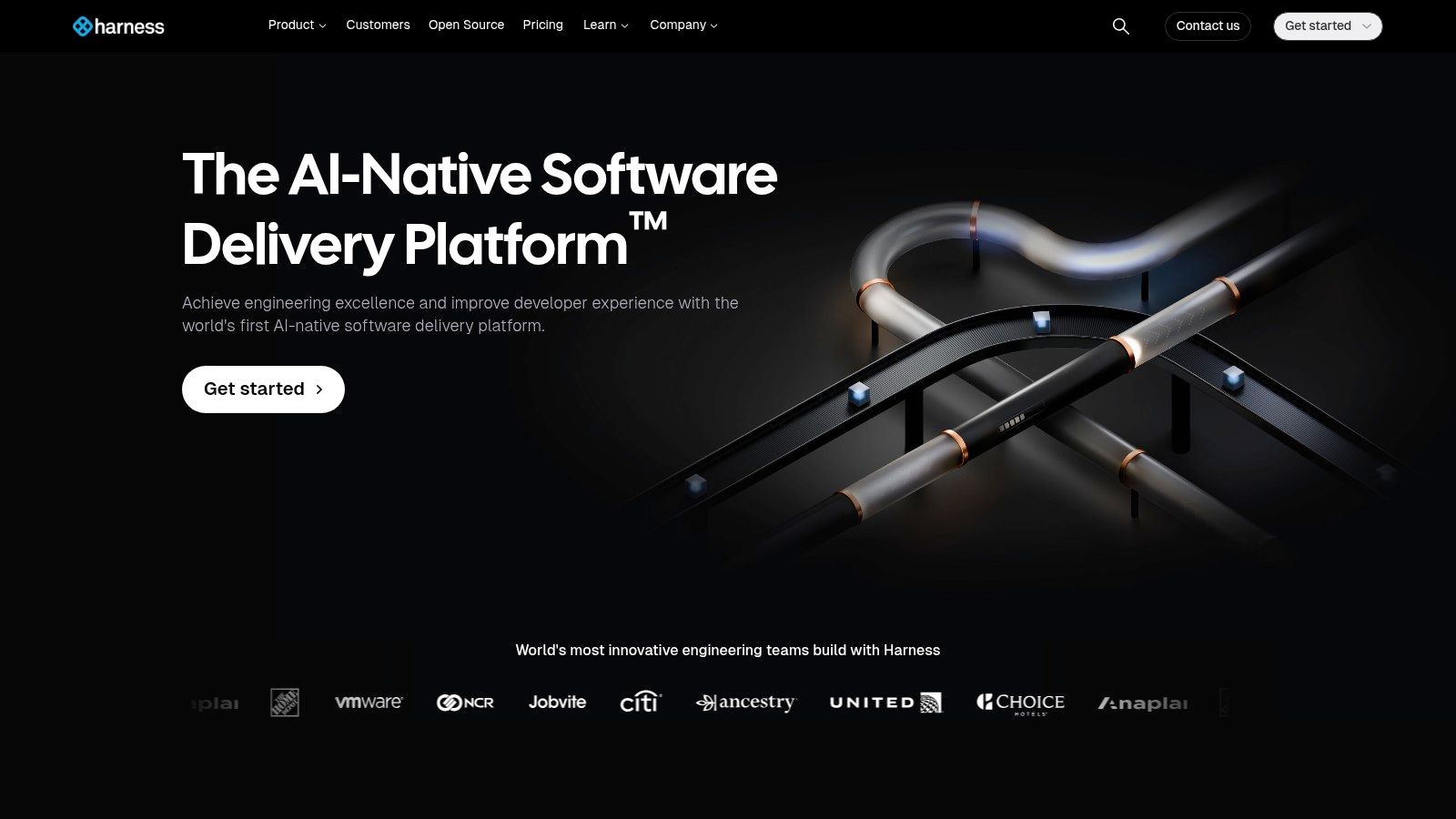
The platform extends its automation capabilities to commitment orchestration for AWS Savings Plans and Reserved Instances, ensuring that you maximize discounts without manual analysis. For teams heavily invested in containerization, Harness provides deep visibility into Kubernetes costs, offering granular breakdowns and rightsizing recommendations. This focus on automation makes it one of the best cloud cost optimization tools for organizations with dynamic, ephemeral infrastructure.
Key Considerations
- Automation Focus: The AutoStopping feature is a key differentiator, providing immediate and tangible savings on ephemeral resources that are often overlooked.
- Pricing Model: Harness offers transparent, spend-based pricing tiers, which can be procured directly or through the AWS Marketplace for consolidated billing.
- Implementation: Achieving full functionality for features like AutoStopping requires deploying a Harness agent and configuring appropriate permissions within your cloud environment.
| Feature | Analysis |
|---|---|
| AutoStopping | Automatically detects and shuts down idle resources like VMs and Kubernetes clusters, saving costs on non-production workloads. |
| Commitment Orchestration | Maximizes the utilization of Savings Plans and RIs by automating purchasing and management based on usage patterns. |
| Kubernetes Cost Visibility | Provides detailed cost allocation for containers, pods, and namespaces, enabling precise chargebacks and rightsizing. |
Practical Tip: Start by implementing AutoStopping in a single development or staging environment to quantify its impact. This provides a clear business case for a broader rollout. Integrating such automated tools is a sign of a mature DevOps culture, which you can evaluate with a DevOps maturity assessment.
Website: www.harness.io/
7. Apptio Cloudability
Apptio Cloudability is an enterprise-grade FinOps platform, now part of IBM, designed for large organizations navigating complex multi-cloud environments. Its core strength lies in providing granular cost visibility, allocation, and forecasting, enabling mature financial governance. The platform ingests and normalizes billing data from AWS, Azure, and GCP, translating arcane cloud bills into clear, business-centric financial reports. This makes it a powerful tool for finance and IT leaders aiming to implement robust showback and chargeback models.
Unlike tools focused purely on engineering-led optimization, Cloudability bridges the gap between finance, IT, and engineering. Its integration with Turbonomic allows it to connect cost data with performance metrics, offering resource optimization actions grounded in both financial impact and application health. For large enterprises, this dual focus makes it one of the best cloud cost optimization tools for establishing a holistic, data-driven FinOps practice that aligns technology spending with business value.
Key Considerations
- Target Audience: Geared towards large enterprises with dedicated FinOps teams or mature cloud financial management processes.
- Implementation: Requires a significant setup effort to configure business mappings, reporting structures, and integrations. This is not a plug-and-play solution.
- Pricing Model: Typically sold via custom enterprise contracts, making it less accessible for small to medium-sized businesses.
| Feature | Analysis |
|---|---|
| Advanced Reporting | Delivers highly customizable dashboards for showback/chargeback, breaking down costs by team, product, or cost center. |
| Container Cost Insights | Provides detailed visibility into Kubernetes costs, allocating shared cluster expenses back to specific teams or applications. |
| Financial Planning | Robust forecasting and budgeting modules allow teams to plan cloud spend accurately and track variance against targets. |
Practical Tip: Leverage Cloudability's Business Mapping feature early in the implementation. By defining custom dimensions based on your organization's tagging strategy, you can create reports that directly align cloud costs with specific business units or projects, making the data instantly actionable for non-technical stakeholders.
Website: www.apptio.com/products/cloudability/
8. Flexera One – Cloud Cost Optimization
Flexera One is an enterprise-grade, multi-cloud management platform that excels in providing deep governance and financial controls. It moves beyond simple cost visibility to offer a robust policy-driven approach to cloud financial management. For organizations managing complex, multi-cloud environments, Flexera One provides the guardrails needed to enforce budget adherence, detect anomalies, and implement chargeback models, making it one of the best cloud cost optimization tools for mature cloud operations.
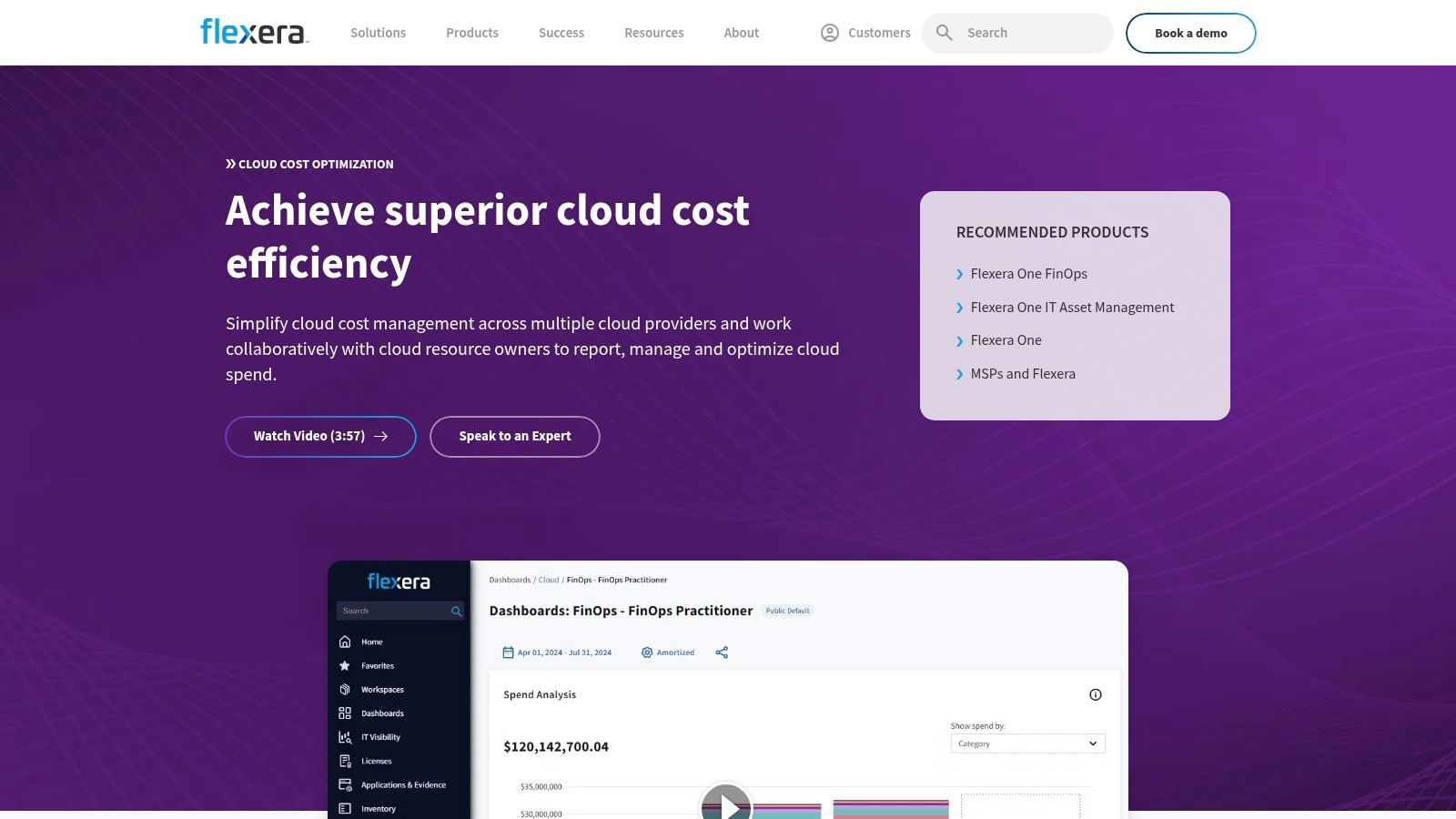
The platform is particularly well-suited for Managed Service Providers (MSPs) and large enterprises that require granular control and automation. Its ability to manage billing across different clouds and provide detailed cost allocation helps finance and engineering teams align on spending. A unique feature is the integration with Greenpixie, which provides tangible sustainability insights by translating cloud usage into CO2e emissions data, a growing priority for many businesses.
Key Considerations
- Pricing Model: Flexera One operates on a contract-based pricing model, which can represent a significant investment. It is available directly or through the AWS Marketplace, offering flexible procurement options.
- Target Audience: The extensive feature set is designed for large-scale operations and may be overly complex for smaller teams or startups with straightforward cloud footprints.
- Governance Focus: Its primary strength lies in its extensive library of over 90 cost policies, which automate the detection and remediation of wasteful spending patterns.
| Feature | Analysis |
|---|---|
| Policy-Driven Automation | Leverages 90+ pre-built policies to automatically identify cost-saving opportunities and anomalies. |
| Multi-Cloud Governance | Provides a single pane of glass for cost allocation, budgeting, and chargeback across AWS, Azure, and GCP. |
| Sustainability Reporting | Integrated Greenpixie data offers CO2e emissions tracking to help achieve corporate green initiatives. |
Practical Tip: Leverage the platform's budgeting and forecasting tools to set proactive alerts. Configure notifications to be sent to specific team Slack channels or email distribution lists when a project's spending forecast exceeds its budget, enabling rapid intervention before costs escalate.
Website: www.flexera.com/products/flexera-one/cloud-cost-optimization
9. Spot by NetApp
Spot by NetApp delivers a powerful automation suite engineered to dramatically reduce compute costs by intelligently managing cloud infrastructure. It excels at automating the use of spot instances, Reserved Instances (RIs), and Savings Plans, ensuring you get the lowest possible price for your workloads without sacrificing performance or availability. For engineering leaders, Spot abstracts away the complexity of managing diverse pricing models, making it one of the best cloud cost optimization tools for achieving hands-off savings.
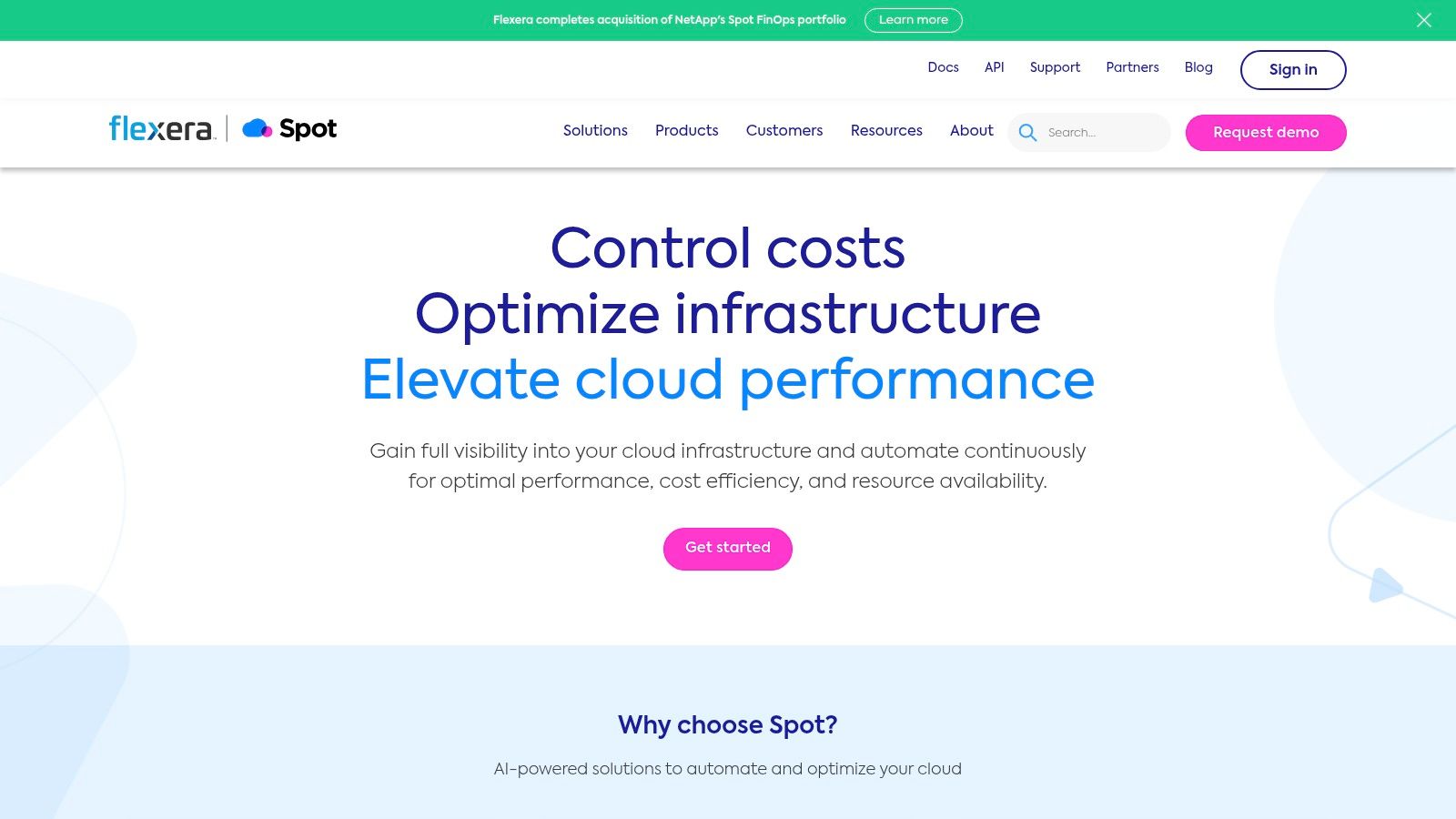
The platform's flagship products, like Ocean for Kubernetes and Elastigroup for other workloads, provide predictive autoscaling and fallbacks to on-demand instances when spot capacity is unavailable. This proactive approach allows teams to confidently run production and mission-critical applications on spot instances, a task that is often too risky to manage manually. The system continuously analyzes your usage patterns and automates the buying and selling of RIs and Savings Plans to maximize your commitment coverage.
Key Considerations
- Automation Focus: Spot is designed for teams that prefer to automate cost management rather than perform manual analysis and tuning. It requires granting significant permissions to your cloud account to execute its automated actions.
- Pricing Model: Its pricing is typically based on a percentage of the savings it generates or a charge per vCPU-hour. This can be complex to forecast but directly ties the tool's cost to its value.
- Technical Integration: The tool integrates deeply into your environment, especially with Kubernetes via Ocean, to manage pod scheduling and node scaling for optimal cost and performance.
| Feature | Analysis |
|---|---|
| Spot Instance Automation | Predicts interruptions and gracefully migrates workloads to other spot pools or on-demand instances, providing an SLA for availability. |
| Commitment Management (Eco) | Automates the entire lifecycle of RIs and Savings Plans, including buying, selling, and modification, to maintain high utilization. |
| Kubernetes Autoscaling (Ocean) | Optimizes container deployments by right-sizing pods and using the most cost-effective mix of spot, reserved, and on-demand nodes. |
Practical Tip: Start by deploying Spot's Elastigroup on a non-production, stateless workload. This allows you to safely evaluate its spot instance management capabilities and quantify the potential savings before rolling it out to more critical systems.
Website: spot.io
10. CAST AI
CAST AI is an automation platform designed specifically for Kubernetes cost optimization, offering a powerful suite of tools that work across AWS, GCP, and Azure. Its core function is to analyze Kubernetes workloads in real time and automatically adjust the underlying compute resources to match demand precisely. This is achieved through a combination of intelligent instance selection, rightsizing of pod requests, and advanced scheduling that ensures maximum resource utilization.
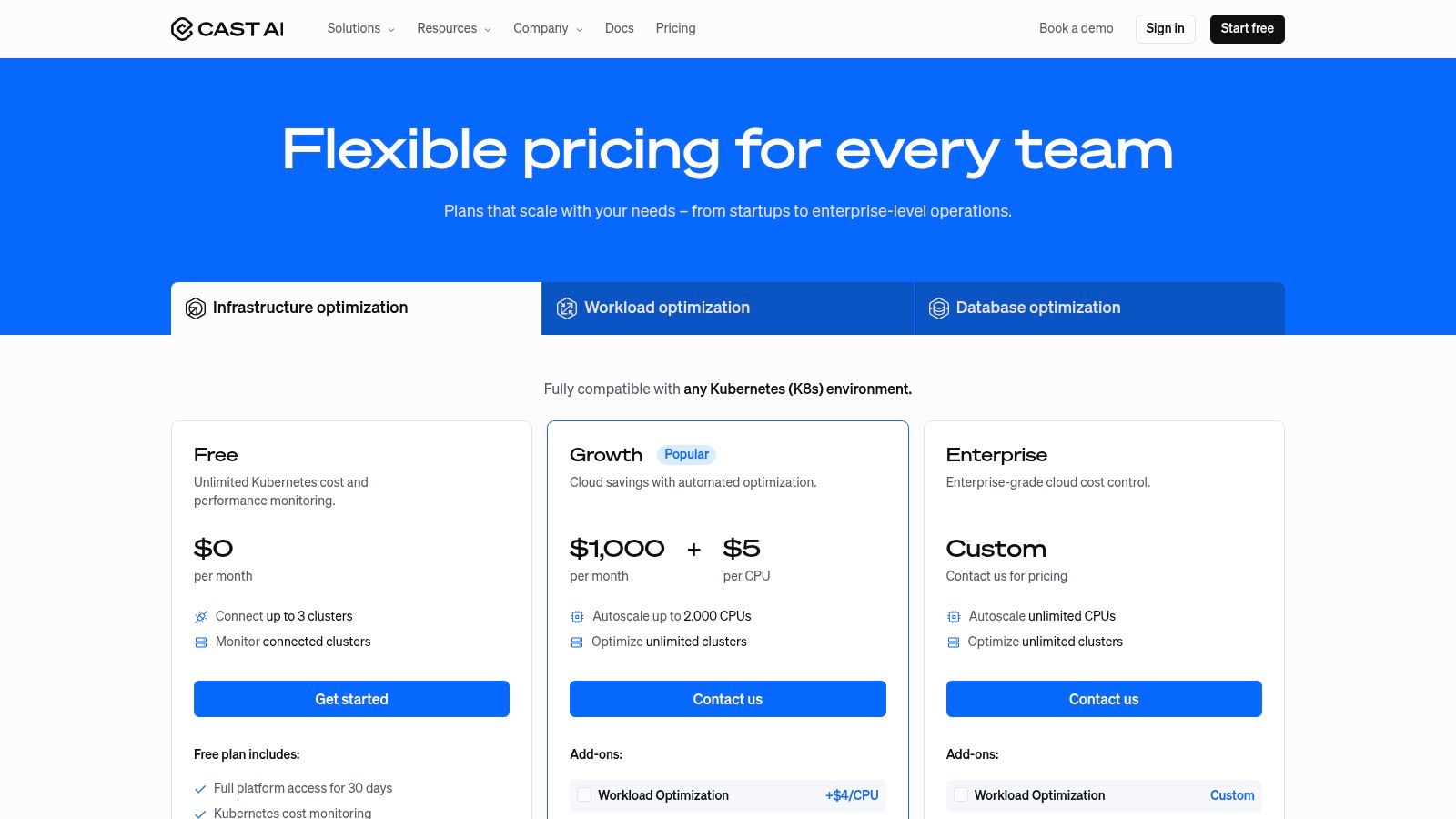
For engineering teams running EKS, GKE, or AKS, CAST AI delivers immediate value by automating complex cost-saving strategies that are difficult to implement manually. Its algorithms continuously rebalance workloads onto the most cost-effective Spot, On-Demand, or Reserved Instances without compromising availability. This makes it one of the best cloud cost optimization tools for organizations that have heavily invested in containerization and are looking to drive down their cloud spend without manual intervention.
Key Considerations
- Kubernetes Focus: The platform is purpose-built for Kubernetes, providing deep, container-aware optimization that generic tools often lack. It is not suitable for non-containerized workloads.
- Automation Level: It goes beyond recommendations by actively managing cluster capacity, automatically provisioning and de-provisioning nodes as needed.
- Pricing Transparency: CAST AI offers a clear, publicly available pricing model, including a free tier for cost monitoring and a savings-based model for its automation features, which aligns its success with the customer's.
| Feature | Analysis |
|---|---|
| Autonomous Rightsizing | Continuously analyzes pod resource requests and adjusts them to eliminate waste and prevent throttling. |
| Spot Instance Automation | Manages Spot Instance lifecycle, including interruption handling and fallback to On-Demand, to maximize savings. |
| Intelligent Bin-Packing | Optimizes pod scheduling to pack workloads onto the fewest nodes possible, reducing idle capacity. |
Practical Tip: Start with the free read-only agent to get a detailed savings report. This report analyzes your current cluster configuration and provides a precise estimate of potential savings, offering a data-driven business case before you enable any automated optimization features.
Website: cast.ai/pricing
11. ProsperOps
ProsperOps provides an autonomous cloud cost optimization service focused specifically on managing AWS Savings Plans and Reserved Instances (RIs). The platform automates the complex process of analyzing compute usage and executing commitment purchases to maximize savings without requiring manual intervention. Its core value is shifting the burden of commitment management from FinOps teams to an automated, algorithm-driven system that continuously optimizes discount instruments.
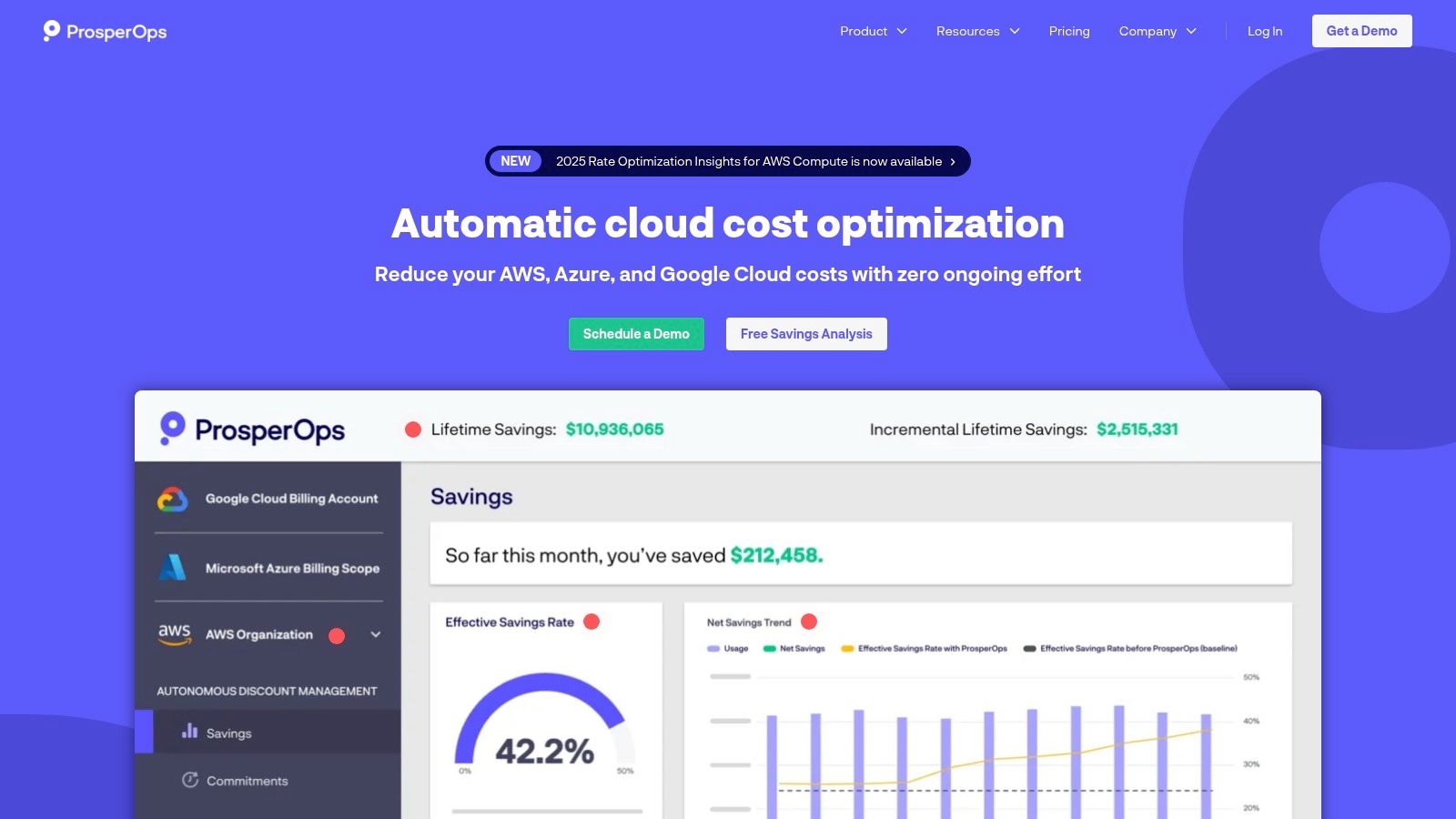
This tool is one of the best cloud cost optimization tools for teams that want a "set it and forget it" solution for their AWS compute spend. Rather than merely providing recommendations, ProsperOps executes the strategy on your behalf, dynamically adjusting commitments as your usage patterns change. Its unique pay-for-performance model, where it takes a percentage of the actual savings it generates, directly aligns its success with your financial outcomes.
Key Considerations
- Automation Level: The service is fully autonomous after initial setup, handling all aspects of commitment portfolio management, including buying, selling, and converting RIs.
- Pricing Model: The outcomes-based pricing (a percentage of savings) eliminates upfront costs and ensures you only pay for tangible results.
- Focus Area: Its specialization is its strength and limitation. It excels at compute commitment optimization but does not address other cost areas like storage, data transfer, or idle resource management.
| Feature | Analysis |
|---|---|
| Autonomous Management | Continuously blends and optimizes Savings Plans and RIs to maintain high coverage and savings rates with zero manual effort. |
| Risk-Aware Strategies | Uses algorithms to manage commitment terms, effectively de-risking long-term lock-in by managing a dynamic portfolio of instruments. |
| Savings Analytics | Provides clear FinOps reporting that tracks Effective Savings Rate (ESR) and demonstrates the value generated by the service. |
Practical Tip: Before onboarding, use your AWS Cost Explorer to understand your baseline compute usage and current Savings Plan/RI coverage. This will help you accurately evaluate the net savings ProsperOps delivers on top of your existing efforts and quantify its ROI.
Website: https://prosperops.com/
12. Kubecost
Kubecost is an open-core cost monitoring and optimization solution built specifically for Kubernetes environments. It provides engineering teams with granular visibility into containerized spending, breaking down costs by namespace, deployment, service, label, and even individual pods. This level of detail empowers developers and platform engineers to understand the financial impact of their architectural decisions directly within their native workflows. It stands out by accurately allocating shared and out-of-cluster resources back to the correct teams.
The platform is designed for self-hosting, giving organizations full control over their cost data, a crucial factor for security-conscious teams. Kubecost translates complex cloud bills from AWS, GCP, and Azure into a clear, Kubernetes-centric context, making it one of the best cloud cost optimization tools for organizations scaling their container strategy. Its actionable recommendations for rightsizing cluster nodes and workloads help prevent overprovisioning before it impacts the bottom line.
Key Considerations
- Deployment Model: Can be installed directly into your Kubernetes cluster in minutes with a simple Helm chart. The core data remains within your infrastructure.
- Target Environment: Its strength lies entirely within Kubernetes. Organizations with significant non-containerized workloads will need a separate tool to gain a complete cost overview.
- Pricing: A powerful free and open-source tier provides core cost allocation. Paid plans unlock advanced features like long-term metric retention, SAML/SSO integration, and enterprise-grade support.
| Feature | Analysis |
|---|---|
| Granular Cost Allocation | Breaks down K8s costs by any native concept like namespace, pod, or label for precise showback and chargeback. |
| Rightsizing Recommendations | Actively analyzes workload utilization to suggest changes to container requests and limits, reducing waste. |
| Multi-Cloud and On-Prem | Ingests billing data from major cloud providers and supports on-premise clusters for a unified view of all Kubernetes spending. |
Practical Tip: Start with the free, open-source version to establish a baseline of your Kubernetes spending. Use its cost allocation reports to identify your most expensive namespaces and workloads, creating an immediate, data-driven priority list for optimization efforts.
Website: www.kubecost.com
Cloud Cost Optimization Tools Comparison
| Solution | Core Features | User Experience / Quality | Value Proposition | Target Audience | Price & Licensing |
|---|---|---|---|---|---|
| AWS Marketplace – Cloud cost management solutions hub | Centralized catalog, procurement, billing | Simplifies vendor management, easy trials | One-stop-shop for AWS-aligned tools | US-based enterprises | Vendor-dependent pricing, private offers |
| AWS Cost Explorer | Cost visualization, forecasting, API access | Native AWS tool, no extra subscription | Baseline tool with deep AWS billing integration | AWS users | No separate license, small API fees |
| Microsoft Azure Cost Management + Billing | Budgets, anomaly alerts, Power BI integration | Enterprise-grade reporting, strong governance | Built-in Azure FinOps suite | Azure users | Included with Azure account |
| Google Cloud cost management stack | Budgets, alerts, recommender insights | No extra cost, integrated recommendations | Native GCP spend optimization | Google Cloud users | Free with GCP account |
| CloudZero | Cost per customer/feature telemetry | Product-level insights, AWS Marketplace purchases | SaaS economics focus | SaaS and product teams | Pricing scales with AWS spend |
| Harness Cloud Cost Management | AutoStopping, commitment orchestration, Kubernetes | Automates savings, transparent Marketplace pricing | Automated savings for complex environments | AWS/Kubernetes users | Transparent tier pricing via Marketplace |
| Apptio Cloudability | Advanced reporting, chargeback, forecasting | Robust enterprise controls | Enterprise-grade FinOps | Large enterprises | Enterprise pricing, custom contracts |
| Flexera One – Cloud Cost Optimization | Cost policies, anomaly detection, sustainability | Broad enterprise governance | Multi-cloud optimization and governance | Enterprises, MSPs | Contract-based pricing |
| Spot by NetApp | Automated RI/Savings Plans management, autoscaling | Hands-off compute savings | Strong compute cost automation | Automation-focused teams | Savings share or vCPU-hour pricing |
| CAST AI | Kubernetes rightsizing, Spot automation, real-time | Transparent pricing, free monitoring tier | Kubernetes cost automation | Kubernetes users | Public pricing with free tier |
| ProsperOps | Savings Plans and RI optimization | Outcomes-based pricing, minimal management | Optimizes AWS compute commitments | AWS users focused on savings | Pay-for-performance based on savings |
| Kubecost | Kubernetes cost allocation, savings, budgets/alerts | Free tier, self-hosted and SaaS options | Popular K8s cost management | Kubernetes operators | Free tier, paid enterprise subscriptions |
Integrating FinOps Tools into Your DevOps Workflow
The journey through the landscape of the best cloud cost optimization tools reveals a clear truth: there is no single, perfect solution for every organization. Your ideal toolset depends entirely on your specific cloud environment, technical maturity, and organizational structure. From the foundational, native services like AWS Cost Explorer and Google Cloud's cost management stack to sophisticated, AI-driven platforms such as CAST AI and ProsperOps, the options are as diverse as the challenges they aim to solve. The key is not just to select a tool but to build a comprehensive strategy around it.
A recurring theme across our analysis of platforms like CloudZero, Harness, and Kubecost is the critical need for granular visibility. Abstract, high-level spending reports are no longer sufficient. Modern engineering teams require unit cost economics, allowing them to attribute every dollar of cloud spend to a specific feature, customer, or product line. This level of detail transforms cost from an opaque, top-down metric into a tangible piece of feedback that developers can act upon directly within their workflows.
From Tool Selection to Strategic Implementation
Choosing a tool is the starting point, not the finish line. The real challenge lies in weaving cost-awareness into the very fabric of your engineering culture. This process, often called FinOps, is a cultural and operational shift that empowers engineers with the data and autonomy to make cost-conscious decisions. Simply deploying a tool without changing your processes will yield limited results.
To truly succeed, consider these critical implementation factors:
- Integration with CI/CD: The most effective cost optimization happens pre-production. Integrate cost estimation and anomaly detection directly into your CI/CD pipelines. Tools that provide this feedback loop, like Harness, can prevent costly architectural decisions from ever reaching production.
- Defining Ownership and Governance: Who is responsible for acting on cost recommendations? Establish clear ownership at the team or service level. Create automated policies and governance rules to enforce budgets and tag compliance, preventing cost issues before they escalate.
- Automating Savings: Manual intervention is not a scalable strategy. Leverage the powerful automation capabilities of tools like Spot by NetApp for instance management or ProsperOps for Savings Plan and Reserved Instance optimization. The goal is to create a self-healing, cost-efficient infrastructure that requires minimal human oversight.
- Kubernetes-Specific Focus: If your workloads are containerized, a generic cloud cost tool will miss critical nuances. Solutions like Kubecost and CAST AI are purpose-built to provide pod-level cost allocation and automated node right-sizing, addressing the unique challenges of managing Kubernetes expenses.
Making the Right Choice for Your Team
To navigate this complex decision, start by evaluating your organization's primary pain points.
- For multi-cloud or complex environments: Platforms like Flexera One or Apptio Cloudability offer robust, enterprise-grade capabilities for managing diverse cloud estates.
- For engineering-led FinOps cultures: CloudZero and Harness excel at providing the granular, contextualized cost data that developers need to understand the impact of their code.
- For heavy Kubernetes users: Prioritize specialized tools like CAST AI or Kubecost that offer deep container-level visibility and automated optimization.
- For maximizing commitment discounts: ProsperOps provides a focused, "set it and forget it" solution for automating Reserved Instances and Savings Plans, delivering predictable savings with minimal effort.
Ultimately, the goal is to create a symbiotic relationship between your DevOps practices and financial objectives. By embedding cost visibility and optimization directly into the software delivery lifecycle, you transform cloud cost management from a reactive, firefighting exercise into a proactive, strategic advantage. This integrated approach ensures that as you innovate and scale faster, you also do so more efficiently and profitably.
Navigating the implementation of these powerful tools and fostering a true FinOps culture requires specialized expertise. OpsMoon provides access to the top 0.7% of global DevOps and SRE talent who can help you select, integrate, and manage the best cloud cost optimization tools for your unique needs. Let OpsMoon help you build a cost-efficient, scalable cloud infrastructure today.
